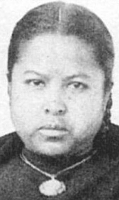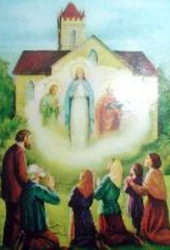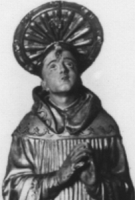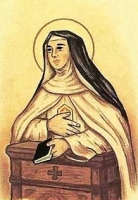Queenship of Mary
விண்ணக மண்ணக அரசியான மரியா
(ஆகஸ்ட் 22)
மரியாவை விண்ணக மண்ணைக அரசியாக ஏற்று, விழாக் கொண்டாடும் வழக்கம் 1954 ஆம் ஆண்டுதான் உருவாக்கப்பட்டது என்றாலும், மரியாவை அரசியாக அழைக்கின்ற வழக்கம் பதினாறாம் நூற்றாண்டிலிருந்தே இருந்து வந்திருக்கின்றது. தூய எப்ராகிம் மரியாவை அரசியாகப் பாவித்து அழைத்ததற்கான குறிப்புகள் இருக்கின்றன. அது போன்று மக்களும் மரியாவை அரசியாக ஏற்றுக்கொண்டதற்கான சான்றுகள் இருக்கின்றான் ‘Hail holy Queen, Queen of Heaven’ என்ற சொல்லாடல்கள் எல்லாம் அதற்குச் சான்றாக அமைகின்றன.
கி. பி. 425 ஆம் ஆண்டு எபேசு நகரில் நடைபெற்ற சங்கம் மரியாவை ஆண்டவரின் தாய் எனப் பிரகடனம் செய்தது. இயேசு ஆண்டவர் என்றால் மரியா ஆண்டவள், அரசி என்பதுதான் அர்த்தமாக இருக்கின்றது. யூதர்கள் வழக்கமாக அரசரின் அன்னையை அரசியாக அழைப்பார்கள். இயேசு அரசருக்கெல்லாம் அரசர். அப்படியானால் ‘மரியாவை படைப்பிற்கெல்லாம் அரசி’ என்று அழைப்பது தகுதியும் நீதியும் ஆகும்.
மரியா விண்ணக மண்ணக அரசி என்றால், விண்ணகத்தில் அவர் இயேசுவின் அருகே இருந்து நமக்காகப் பரிந்து பேசுகின்றார் என்பத்தான் அர்த்தமாக இருக்கின்றது. ஆகவே, நாம் மிகுந்த நம்பிக்கையோடு அன்னை மரியிடம் நம்முடைய வேண்டுதல்களை, ஜெபங்களை எடுத்துரைக்கும் போது அவர் நமக்காக தன் மகன் இயேசுவிடம் பரிந்துரைந்து, நமக்கு வேண்டியதைப் பெற்றுத் தருவார் என்பதுதான் உண்மையாக இருக்கின்றது.
Also known as
Also known as
• Nossa Senhora Rainha do Mundo
• Our Lady, Queen of the Angels
• Our Lady, Queen of Heaven
Article
A Marian feast day decreed by Pope Pius XII in his encyclical Ad caeli reginam to recognize and celebrate the Blessed Virgin Mary as Queen of the world, of the angels, of heaven, etc. The movement to officially recognise the Queenship of Mary was initially promoted by several Catholic Mariological congresses in Lyon, France, Freiburg, Germany, and Einsiedeln, Switzerland. Pro Regalitate Mariae, an international society to promote the Queenship of Mary, was founded in Rome, Italy by noted Marioligist and writer Father Gabriel Roschini.
Patronage
diocese of Cabinda, Angola
St. Hippolytus of Porto
Feastday: August 22
Death: 236
Bishop and martyr of Porto, Italy. He was drowned in Porto or in Ostia. His cult was suppressed in 1969.
Saint Philip Benizi
புனித பிலிப்பு பெனிடியுஸ்
(Saint Philip Benitius )
Philippus Benitius Philippus Benitius OSM
சபை நிறுவுனர்
பிறப்பு : 15 ஆகஸ்டு 1233,
புளோரன்ஸ் Florenz, இத்தாலி
இறப்பு : 22 ஆகஸ்டு 1285,
டோடி Todi, இத்தாலி
புனிதர்பட்டம்: 1671, திருத்தந்தை 10 ஆம் கிளமெண்ட்
பாதுகாவல்: சர்வைட் சபைக்கு
இவர் பெண்களுக்கான "சர்வைட்" Servites என்ற சபையை நிறுவினார். இவர் பாரிஸ் மற்றும் பதுவையில் Padua தனது மருத்துவ படிப்பையும், தத்துவயியல் படிப்பையும் படித்தார். தனது 19 ஆம் வயதில் சர்வைட் சபையில் சேர்ந்து ஏழு ஆண்டுகள் கழித்து 1259 ல் குருப்பட்டம் பெற்றார். 1267 ல் சர்வைட் சபையை வழிநடத்தும் பொறுப்பை ஏற்றார். தனது சபையை வலிமை பெற்ற சபையாக மாற்றினார். பின்னர் இத்தாலி ஜெர்மனி போன்ற ஐரோப்பிய நாடுகளுக்கு சென்று மிஷினரியாக பணியாற்றினார். அந்நாடுகளில் தன் சபையை பரப்பி, சில சர்வைட் துறவற இல்லங்களையும் கட்டினார்.
இவர் சிறப்பாக ஏழைகளுக்கும், நோயாளிகளுக்கும் பணிபுரிந்தார். வாழ்வில் எதுவுமே இல்லையென்றுணர்ந்த மக்களை, தன் இதயத்தில் சுமந்து, வாழ்விற்கு வழிகாட்டினார். எண்ணிலடங்கா ஏழைகளின் வாழ்வில் ஒளியேற்றினார்.
செபம்:
என்றும் வாழும் எல்லாம் வல்ல தந்தையே! புனித பிலிப்பு பெனிடியுஸ் வழியாக பெண்களுக்கான சர்வைட் சபையை உருவாக்கினார். அறுவடையோ மிகுதி, வேலையாட்களோ குறைவு. இவ்வுலகில் உமது பணியை தொடர்ந்து ஆற்ற இச்சபைக்கு தேவையான தேவ அழைத்தலைத் தாரும். இச்சபை கன்னியர்களோடு, உடனிருந்து வழிநடத்தியருளும். இச்சபையை வழிநடத்தும் சபை பொறுப்பாளர்களுக்கு தேவையான ஆவியின் அருள்கொடைகல் அனைத்தையும் தந்து, ஆசீர்வதித்திட வேண்டுமென்று இப்புனிதரின் வழியாக இறைவா உம்மை மன்றாடுகின்றோம்.
Also known as
• Felipe Benicio
• Filip Benizi
• Philip Benitius
Profile
Born to the Italian nobility. Brilliant student. Studied medicine at Paris, France, and Padua, Italy, receiving his doctorates in medicine and philosophy by age 19. Practiced medicine for about a year, but following a vision of the Virgin Mary, he quit to join the Servites as a lay brother at Monte Senario in 1254. Ordained at Siena, Italy in 1258. Tried to hide his education so he could remain a simple member of the Order, but he was persuaded to use his gifts and background to further the Servite mission. Novice master at Siena in 1262.
Sent to Forli, Italy to resolve a conflict between the papacy and the emperor, he was heckled and then physically attacked while preaching. Philip turned the other cheek. Father Philip's non-violent ways caused a converion in Peregrine Laziosi who later became a Servite saint.
Superior of several Servite friaries. Elected prior-general of the order on 5 June 1267, much against his protests. Attended the Council of Lyons. Codified the Servite rules, and defended against attempts to disband it in the wake of the Second Council of Lyons which put restrictions on mendicant orders. Worked to bring peace to the Guelphs and Ghibellines in 1279. He was considered a candidate for the papacy at one point; when he heard the rumor, he went into hiding on Mount Tuniato until Pope Saint Gregory X was chosen. Worked with Blessed Andrew Dotti. Helped Saint Juliana of Cornillon found the Servite third order. Dispatched the first Servite missionaries to the East in 1284. Lived his last few months in retirement in a Servite house in Todi, Italy.
Miracle worker and healer. He once met a leper on the road, and gave the man his cloak; the leprosy was instantly cured.
Born
15 August (Feast of the Assumption) 1233 at district of Oltrarno, Florence, Italy
Died
• 22 August (Octave of the Assumption) 1285 at Todi, Italy
• buried in Todi
Canonized
• 12 April 1671 by Pope Clement X
• first Servite to be canonized
Patronage
Sergio Osmena, Zamboanga del Norte, Philippines
Saint John Kemble
Additional Memorials
• 25 October as one of the Forty Martyrs of England and Wales
• 29 October as one of the Martyrs of Douai
Profile
Son of John and Anne Kemble. Studied at Douai, France. Ordained on 23 February 1625 at Douai College. Returned to England on 4 June 1625 as a missioner in Monmouthshire and Herefordshire. He tended to his covert flock for 53 years.
Arrested at Pembridge Castle, the home of a family member, in 1678, and lodged in Hereford Gaol. Falsely accused of being part of the Titus Oates Plot. Condemned in March 1679 for the treason of Catholic priesthood. Martryed at age 80.
Before leaving for his execution, John sat for a while with the under-sheriff, having a final drink and smoking a final pipe. This led to the Herefordshire expression "Kemble cup" and "Kemble pipe", meaning one taken before a parting.
Born
1599 at Rhydica Farm, Saint Weonard's Parish, Herefordshire, England
Died
• hanged, drawn, and quartered on 22 August 1679 at Widemarsh Common, Hereford, England
• so well respected in the area that he was permitted to die on the gallows and avoid the agony of the drawing and quartering elements
• buried in the Welsh Newton Churchyard
• his hand is preserved as a relic at Saint Francis Xavier's church, Hereford, England
Canonized
25 October 1970 by Pope Paul VI
Blessed Giacomo Bianconi of Mevania
Also known as
• Giacomo Bianconi da Bevagna
• James Bianconi
• James of Bevagna
• Jacobus de Blanconibus de Mevania
Profile
Joined the Dominicans at Spoleto, Italy at age 16 in 1236, choosing a life of extreme poverty even by Dominican standards. Founder and first prior of a Dominican friary in Mevania, Italy. Aided survivors and refugees in Mevania after it was sacked by emporer Frederick II in 1248. Helped quash the return of the Nicholaites anti-montanist heresy in Umbria, Italy. Reputed miracle worker.
Born
7 March 1220 at Mevania (modern Bevagna), diocese of Spoleto, Umbria, Italy as Giacomo Bianconi
Died
22 August 1301 at Mevania, Italy of natural causes
Beatified
• 1400 by Pope Boniface IX (cultus confirmed)
• 18 May 1672 by Pope Clement X (cultus confirmed)
Saint John Wall
Also known as
• Francis Dormore
• Francis Johnson
• Francis Webb
• Joachim of Saint Anne
• John Marsh
Additional Memorials
• 25 October as one of the Forty Martyrs of England and Wales
• 29 October as one of the Martyrs of Douai
Profile
Born to a wealthy Catholic family. Studied in Douai, France and entered the Roman College on 5 November 1641, using the name John Marsh. Ordained 3 December 1645. Joined the Friars Minor in Rome on 1 January 1651, taking the name Joachim of Saint Anne. Vicar and novice-master at Douai. Joined the Worcester mission in 1656 where he served for over 20 years, using several aliases, and living as a fugitive. Arrested in connection with the Titus Oates Plot in December 1678; acquitted of participation in the plot, but was martyred for the crime of priesthood.
Born
1620 Chingle Hall near Preston, Lancashire, England
Died
• hanged, drawn, and quartered on 22 August 1679 near Redhill, Corcester, England
• buried at Saint Oswald's church
Canonized
25 October 1970 by Pope Paul VI
Saint Symphorian of Autun
Profile
Born to the imperial Roman nobility, the son of Senator Faustus and Blessed Augusta. Covert Christian. As a young man he studied at Autun, Gaul (in modern France). There he was arrested by provincial governor Heraclius for not worshipping the pagan goddess Cybele, he asked for tools to destroy the statue. Arrested and flogged for heresy. Because he was from a noble family, he was given a chance to recant, and was even offered bribes to do so; he declined. Martyred in the presence of his mother.
Died
• beheaded by sword on 22 August 178
• a basilica was built over his tomb in the late 5th century by Saint Euphronius of Autun
Patronage
• against eye problems
• against syphilis
• children
• students, school children
• Autun, France
Saint Andrew of Fiesole
புனிதர் ஆண்ட்ரூ ஸ்காட்
(St. Andrew the Scot)
தலைமைக் குருவின் பெரிய உதவி அதிகாரி:
(Archdeacon)
பிறப்பு: கி.பி. 800
இறப்பு: கி.பி. 877 அல்லது 880
ஃபியசோல், இத்தாலி
(Fiesole, Italy)
ஏற்கும் சமயம்:
ரோமன் கத்தோலிக்க திருச்சபை
(Roman Catholic Church)
கிழக்கு மரபுவழி திருச்சபை
(Eastern Orthodox Church)
முக்கிய திருத்தலம்:
புனித மார்ட்டின் தேவாலயம், ஃபியசோல், இத்தாலி
(Saint Martin, Fiesole, Italy)
புனிதர் ஆண்ட்ரூ ஸ்காட் (St. Andrew the Scot), இத்தாலிய பிராந்தியமான “டுஸ்கனியின்” (Tuscany) பெருநகரான “ஃபுளோரன்ஸின்” (Metropolitan City of Florence) பகுதியான “ஃபியசோலின்” (Fiesole) ஆயரான “புனிதர் டோனடஸின்” (St. Donatus) “பெரிய உதவி அதிகாரி” (Archdeacon) ஆவார். இவர் “டஸ்கனியின் ஆண்ட்ரூ” (Andrew of Tuscany) என்றும், “ஃபியசோல் நகர ஆண்ட்ரூ” (Andrew of Fiesole) என்றும், “அயர்லாந்தின் ஆண்ட்ரூ” (Andrew of Ireland) என்றும் அறியப்படுகிறார். இவர், புனிதர் பிரிட்ஜெட்’டின் (Bridget of Fiesole) சகோதரரும் ஆவார்.
“அயர்லாந்து” அல்லது “ஸ்காட்லாந்து” (Ireland or Scotland) நாட்டில் பிறந்ததாக கூறப்படும் இவர், இத்தாலியிலுள்ள “டுஸ்கனியின்” (Tuscany) “ஃபுளோரன்ஸிலுள்ள” (Florence) “ஃபியசோல்” (Fiesole) நகரில் மரித்தார்.
ஆண்ட்ரூவும் அவரது சகோதரியும் புனிதர் டோனடஸிடம்” (St. Donatus) கல்வி கற்றனர். டோனடஸ் இத்தாலிக்கு புனித யாத்திரை சென்றபோது, ஆண்ட்ரூவும் உடன் சென்றார். டோனடஸ், ஆண்ட்ரூ இருவரும் ஃபியசோல் சென்று சேர்ந்தபோது, அங்குள்ள மக்கள், தமக்கு ஒரு ஆயரை தேர்ந்தெடுப்பதற்காக ஒன்றுகூடியிருந்தனர். அப்போது, வானிலிருந்து இறங்கி வந்த அசரீரி குரல் ஒன்று, டோனடசை சுட்டிக்காட்டி, “இவரே மரியாதைக்கு மிகவும் தகுதியுள்ளவர்” என்றது. ஆயராக நியமிக்கப்பட்டு, பொறுப்பேற்றுக்கொண்டதும், டோனடஸ் தமது “பெரிய உதவி அதிகாரியாக” (Archdeacon) ஆண்ட்ரூவை நியமித்துக்கொண்டார்.
ஃபியசோல் நகரிலிருந்தபோது, பிரபு ஒருவரின் மகள் ஒருவர் இவரால் குணமடைந்ததாக கூறப்படுகிறது. முடக்குவாத நோயால் பாதிக்கப்பட்டிருந்த சிறுமியை காப்பாற்ற மருத்துவர்களால் இயலவில்ல என்றானதும், சிறுமியின் தந்தை, ஆண்ட்ரூவை வந்து தமது மகளுக்காக செபிக்குமாறு வேண்டினார். சிறுமியின் படுக்கையருகே முழங்கால்படியிட்டு செபித்த ஆண்ட்ரூம், “உன்னை இயேசு குனமாக்கிவிட்டார்; எழுந்திரு” என்றார். அந்த சிறுமியும் எழுந்து சென்றாள். ஃபியசோல் நகரில் “பெரிய உதவி அதிகாரியாக” (Archdeacon) இருந்த காலத்தில், இதுபோல் பல அற்புதங்களை இயேசுவின் பெயரால் நிகழ்த்தியதாக கூறப்படுகின்றது. பிசாசுக்களை துரத்தினார். பார்வையற்றவர்களுக்கு பார்வை வரவழைத்தார். நோயுற்றோரை குணமாக்கினார்.
நாற்பத்தேழு வருட ஆயராக சேவையில், ஆண்ட்ரூ டோனடஸுக்கு தீவிர விசுவாசமாக பணியாற்றினார். “மென்சுலா” நகரிலுள்ள “புனித மார்ட்டின் ஆலயத்தை” (Church of San Martino di Mensula) மீட்கவும் அங்கே ஒரு துறவியர் மடத்தை உருவாக்கவும் உந்துசக்தியாக விளங்கினார். தமது கடினமான, மற்றும் எளிய வாழ்க்கைக்காகவும், ஏழைகளுக்கு இவர் ஆற்றிய எல்லையற்ற தொண்டுகளுக்காகவும் ஆண்ட்ரூ பாராட்டப்படுகிறார். இவர், தமது ஆசான் டோனடஸ் மரித்த சில காலத்திலேயே இவரும் மரித்தார். இவர் மரண படுக்கையிலிருந்தபோது, இவருக்கு உதவுவதற்காக இவரது சகோதரி புனிதர் பிரிட்ஜெட்’டை (Bridget of Fiesole) அயர்லாந்திலிருந்து ஒரு தேவதூதர் அழைத்து வந்ததாக கூறப்படுகிறது. இவர் மீட்டெடுத்த புனித மார்ட்டின் தேவாலயத்தில் (St. Martin's Church) இவரது உடல் அடக்கம் செய்யப்பட்டது.
Also known as
• Andrew of Ireland
• Andrew of Tuscany
• Andrew the Scot
Profile
Born to the Irish nobility. Brother of Saint Bridget the Younger. Educated by Saint Donatus of Fiesoli, and made a pilgimage to Rome, Italy with him in 816. When Donatus was miraculously chosen bishop of Fiesole, Italy, Andrew was ordained as archdeacon. He served for 47 years, restored the church of Saint Martin and founded a monastery in Mensola, Italy where he may have lived for a while as a monk. He was known as "the Scot", common in that day when speaking of some one from Ireland. Legend says that as he lay dying, his sister was brought to him his bedside by an angel for a final farewell. Little is known of his life, which caused many later writers to fill in the details with pious fiction.
Born
Ireland
Died
• c.877 in Italy of natural causes
• relics in the church of Saint Martin, Fiesole, Italy
Blessed William Lacey
Additional Memorial
29 October as one of the Martyrs of Douai
Profile
Married to a widow name Creswell; both his step-sons from that marriage became Jesuits. He held a civil service position, possibly as coroner, until c.1565 when he began to be persecuted for his Catholicism. Imprisoned for a while at Hull. Widower. He travelled to the European continent in 1580, staying in Rheims and then Pont-a-Mousson in France, and then in Rome, Italy where he obtained dispensation to study for the priesthood. After ordination, he returned to England to minister to covert Catholics. Arrested in York Castle on 22 July 1582 for the crime of priesthood. Abused, loaded with chains, imprisoned underground, and repeatedly interrogated before being executed for being a priest. Martyr.
Born
in Horton, Yorkshire, England
Died
22 August 1582 in York, North Yorkshire, England
Beatified
29 December 1886 by Pope Leo XIII (cultus confirmed)
Blessed Symeon Lukach
Also known as
Simeon Lukac
Profile
Greek Catholic. Born to a farm family. Entered the seminary in 1913; his studies were interrupted by World War I, but he graduated in and was ordained in 1919. Taught moral theology at the seminary in Ivano-Franksivsk. Believed to have been secretly ordained a bishop in April 1945; the secrecy was necessitated by Soviet persecution of the Church. Arrested for his faith by Soviet secret police on 26 October 1949; held until 11 February 1955. Worked as a covert priest after his release. Imprisoned again in July 1962. Contracted tuberculosis and died in prison. Martyr.
Born
7 July 1893 at Starunya, Ivano-Frankivs'ka oblast', Ukraine
Died
22 August 1964 in Ivano-Frankivsk, Ivano-Frankivs'ka oblast', Ukraine of tuberculosis
Beatified
27 June 2001 by Pope John Paul II at Ukraine
Blessed Timoteo da Monticchio
Also known as
Timoteo de Mound
Profile
Born to a peasant family and grew up poor but pious. Joined the Franciscan Friars Minor. Priest. Franciscan novice master in Campli, Teramo, Italy, and lived in the San Angelo d'Ocre convent. Noted for his austere devotion to the Franciscan life, his deep prayer life, and devotion to Franciscan saints. Received visions of the Blessed Virgin Mary and Saint Francis of Assisi.
Born
1444 in Monticchio, L'Aquila
Died
22 August 1504 in the San Angelo convent in Ocra, L'Aquila, Abruzzo, Italy of natural causes
Beatified
10 March 1870 by Pope Pius IX (cultus confirmation)
Blessed Élie Leymarie de Laroche
Profile
Priest in the diocese of Verdun, France. Imprisoned on a ship in the harbor of Rochefort, France and left to die during the anti-Catholic persecutions of the French Revolution. One of the Martyrs of the Hulks of Rochefort.
Born
8 January 1758 in Annesse, Dordogne, France
Died
22 August 1794 aboard the prison ship Deux-Associés, in Rochefort, Charente-Maritime, France
Beatified
1 October 1995 by Pope John Paul II
Blessed Bernard Perani
Also known as
Bernard Offida
Profile
Born to a pious peasant family. Capuchin lay brother, joining the Order in 1626. Worked seven years as a cook. Noted for his charity to the poor, his extensive study of scripture and devotional writings, and his spiritual insights. Given to ecstasies during Eucharistic adoration, he was seen to levitate and to shine with an inner light.
Born
c.1604 in Italy
Died
1694 of natural causes
Beatified
25 May 1795 by Pope Pius VI
Blessed Richard Kirkman
Additional Memorial
29 October as one of the Martyrs of Douai
Profile
Studied at Douai, France; ordained in Rheims, France in 1579. Returned to England to minister to covert Catholics. Tutor for Richard Dymake's family in Scrivelsby. Arrested near Wakefield in 1582 for the treason of not accepting the Queen as head of the Church. Martyr.
Born
Addingham, Yorkshire, England
Died
hanged, drawn and quartered on 22 August 1582 at York, England
Beatified
29 December 1886 by Pope Leo XIII (cultus confirmation)
Blessed José Joaquín Erviti Insausti
Also known as
Pascual
Profile
Redemptorist brother, making his profession on 24 February 1935. Martyred in the Spanish Civil War.
Born
11 November 1902 in Echalecu, Navarra, Spain
Died
22 August 1936 in Pradera de San Isidro, Madrid, Spain
Venerated
24 April 2021 by Pope Francis (decree of martyrdom)
Saint Sigfrid of Wearmouth
Profile
Benedictine monk. Spiritual student of Saint Benedict Biscop, and brother monk to Saint Esterwine of Wearmouth and Saint Ceolfrid. Biblical scholar. Co-adjutor abbot of Jarrow Abbey. Abbot in Wearmouth, England in 686.
Died
• 22 August 688 of natural causes related to respiratory illness
• buried in the church of Saint Peter at Jarrow Abbey
Saint Timothy of Rome
Also known as
Timotheus
Profile
Priest in Antioch, Syria. He re-located to Rome, Italy where he became a noted preacher. Martyred in the persecutions of Diocletian.
Born
Syrian
Died
• beheaded c.309 in Rome, Italy
• relics enshrined in a chapel near the church of Saint Paul-outside-the-Walls at Rome, Italy
Saint Gunifort
Also known as
Guniforme, Guniforto, Gunifortus
Additional Memorial
26 August (Pavia, Italy)
Profile
Martyred while on pilgrimage.
Born
in the British Isles
Died
Pavia, Italy, date undetermined
Saint Anthusa of Seleucia
Profile
Wealthy third-century lay woman in Seleucia, Asia Minor. Convert to Christianity, baptized by Saint Athanasius of Tarsus. Driven out of Seleucia due to her faith, she lived as a desert hermitess for 23 years.
Saint Antoninus of Rome
Profile
Imperial government executioner in the reign of Commodus. Convert who had to immediately turn his back on all his previous life.
Died
186
Saint Arnulf of Eynesbury
Profile
Ninth-century hermit whose records have been lost but who has been long venerated in Arnulphsbury, Cambridgeshire, England.
Saint Athanasius of Tarsus
Profile
Bishop of Tarsus in Asia Minor. Martyred in the persecutions of Emperor Valerian.
Died
257
Saint Maurus of Rheims
Profile
Priest. The only one of a group of 50 martyrs whose name has survived.
Died
• c.260 in Rheims, France
Saint Ethelgitha of Northumbria
Profile
Nun. Abbess of a convent in Northumbria, England.
Died
c.720
Saint Fabrician of Toledo
Also known as
Fabricianus
Profile
Martyr.
Died
Toledo, Spain
Saint Philibert of Toledo
Also known as
Filibert
Profile
Martyr.
Died
Toledo, Spain
Saint Saturninus of Ostia
Profile
Martyr honoured in Ostia, Italy.
Died
c.300
Saint Epictetus of Ostia
Profile
Martyr honoured in Ostia, Italy.
Died
c.300
Saint Maprilis of Ostia
Profile
Martyr honoured in Ostia, Italy.
Died
c.300
Saint Martial of Ostia
Profile
Martyr honoured in Ostia, Italy.
Died
• c.300
Saint Felix of Ostia
Profile
Martyr honoured in Ostia, Italy.
Died
c.300
Martyred in the Spanish Civil War
Thousands of people were murdered in the anti-Catholic persecutions of the Spanish Civil War from 1934 to 1939. I have pages on each of them, but in most cases I have only found very minimal information. They are available on the CatholicSaints.Info site through these links:
• Blessed Dalmau Llebaría Torné
• Blessed Joan Farriol Sabaté
• Blessed Josep Roselló Sans
• Blessed Julio Melgar Salgado
• Blessed Narciso de Esténaga y Echevarría
Also celebrated but no entry yet
• Ildebrando di Bagnoregio
• Stefano de Fontsanta
• Thomas Percy
• Timoteo da Monticchio




























